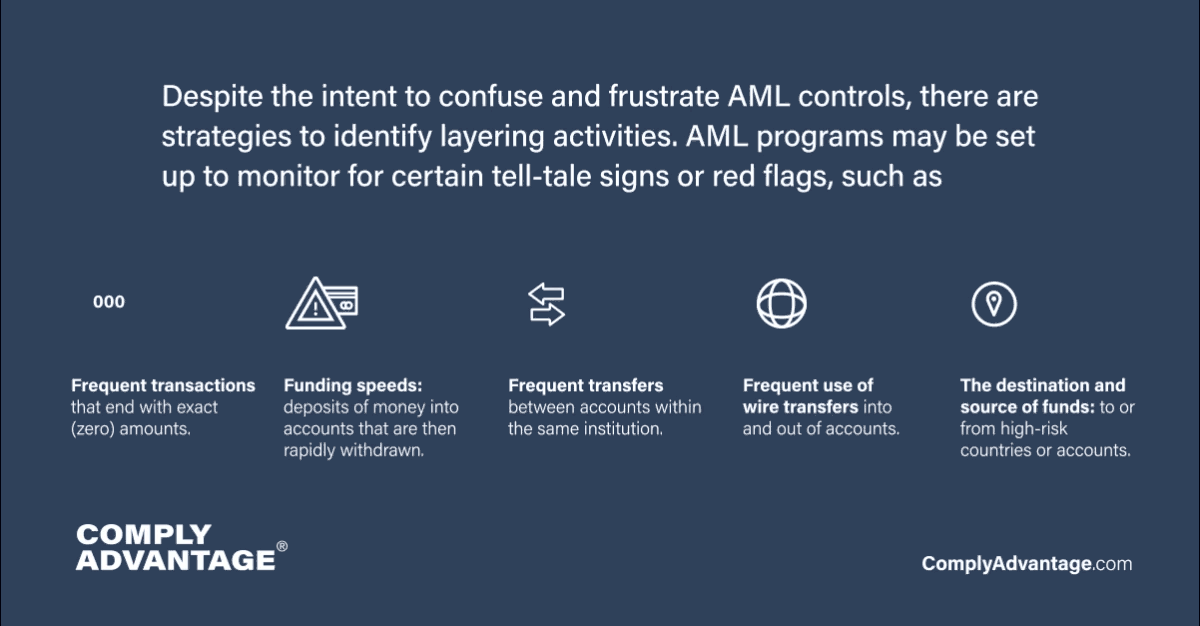
The State of Financial Crime
Stay on top of industry trends and novel criminal techniques so you can protect your business from financial crime.
Download your reportCrimes that generate significant financial proceeds, such as theft, extortion, and drug trafficking, almost always require a money laundering component so criminals can avoid detection by authorities and use their illegally obtained funds in the legitimate economy.
Given the regulatory scrutiny on money laundering in most jurisdictions, criminals must develop a laundering process that evades anti-money laundering (AML) controls. The money laundering process generally includes three stages: placement, layering, and integration. The layering stage in particular refers to the methods criminals use to conceal the illegal source of their funds.
To detect layering, it is important to understand its place in the money laundering process.
Layering is the process of making illicitly obtained money difficult to track by moving the assets around or changing their nature. Layering can be done by transferring illegal funds through multiple accounts around the world or by converting them into real estate properties, gold, casino chips, etc.
Like placement, money laundering layering further distances criminal proceeds from their source, but it primarily serves to reinforce the appearance of legitimacy by passing money through “layers” of transactions or financial instruments. Each layer represents a degree of legal participation in the financial system that increasingly obscures the illegal origin of the funds.
Layering is often considered the most complex component of the money laundering process because it deliberately incorporates multiple financial instruments and transactions to confuse AML controls. There are numerous approaches to layering available to money launderers.
Examples include:
When money launderers need to clean large sums of money, the layering process must become more complex and diverse. Sometimes layering methods will be nested within each other. For example, if “dirty” money was invested into a business, those funds could be funneled into multiple new bank accounts or used to invest on the stock exchange.

Stay on top of industry trends and novel criminal techniques so you can protect your business from financial crime.
Download your report
KYC and AML teams may also be able to pick up on contextual information to detect layering, such as comments customers make about their transactions or information they include on official documents. While screening and monitoring software remains an important AML component, the ability of frontline employees to spot these contextual characteristics is crucial.
One common layering strategy will see a customer withdraw multiple small amounts of cash from accounts where illegal funds were deposited during placement. Each cash withdrawal will be in $100 bills and in an amount too small to trigger the reporting threshold. The cash will then be wire-transferred to an offshore account, consolidated, and then used to purchase a high-value item, such as a painting or a yacht.
In this case, in order to detect layering as part of a money laundering process, an AML program might monitor for red flags, like funds deposited and withdrawn rapidly and in exact amounts.
After sufficient time in the layering process, criminals can extract their funds and reintroduce them to the financial system as legitimate money: this stage of the process is known as integration. While layering costs may have decreased the value of the placed funds, during integration, they will likely still be used to make high-value purchases, such as real estate, luxury goods, or residential or commercial property.
It is likely that criminals will engage banks and financial institutions at this point. To effectively detect laundered money, AML programs must perform robust client screening checks and employ customer due diligence (CDD) measures that are commensurate with the customer’s risk profile. Given the vast amounts of financial data involved in the detection of layering, using an automated AML solution is an opportunity to ease the pressure on KYC and AML teams, eliminate errors, and add speed and accuracy to the process.
Our annual report offers a compliance roadmap for firms, building on a global survey of 600 decision-makers and expert industry analysis.
Download nowOriginally published 30 December 2019, updated 22 January 2025
Disclaimer: This is for general information only. The information presented does not constitute legal advice. ComplyAdvantage accepts no responsibility for any information contained herein and disclaims and excludes any liability in respect of the contents or for action taken based on this information.
Copyright © 2025 IVXS UK Limited (trading as ComplyAdvantage).